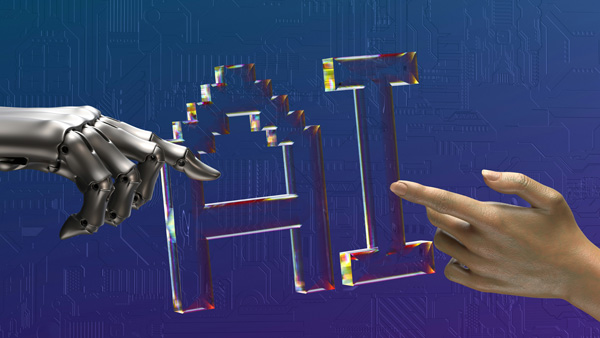AI and robotic technology lead the revolution of human life

[Image of AI and smart robot technology, Credit to Unsplash]
Modern society is going through a continuous wave of technological innovation, and evolving robotic technology and AI are at its core, transforming human lives and suggesting possibilities for a better future.
At the Consumer Electronics Show (CES) 2024 in Las Vegas, the Korean startup company Mand. ro received the Innovation Award for its robotic finger prosthesis 'Mand.ro Mark 7D', a cost-effective and innovative technology expected to dramatically change the lives of people with disabilities.
Supported by the Korea Medical Device Development Fund (KIMDF), this product developed a drive system for myoelectric prosthetic hands which shows great potential to bring significant changes to the daily lives of amputees.
Mand. ro's robotic finger prosthesis reads subtle signals from finger nerves through AI and moves like a real finger.
It can be worn all day without much burden as it only weighs 200g, and the speed and force of movement can be finely adjusted according to the user's needs.
This technological advancement highlights the crucial role of technology not only as a mechanical tool but also in overcoming human physical limitations and exploring new possibilities.
This year, CES saw the emergence of 'enhanced human' technologies that compensate for physical defects or significantly enhance human abilities.
The key focus is on making these prostheses operate naturally and precisely as if they were originally part of our body, even without conscious effort.
Things that were considered impossible until recently due to technological limitations have become possible with advancements in semiconductors, AI technology, and the advent of AIoT (AI of Things).
In 2024, Tesla CEO Elon Musk personally released a video showing the second-generation robot of the 2022 humanoid robot “Optimus” with upgraded AI technology.
In addition, the Japanese company SoftBank Robotics has developed a robot 'Pepper', which has achieved great success in customer service and education.
This robot can recognize emotions and respond accordingly, making interactions with humans more natural.
The robot industry, which had been created for simple labor-intensive industrial tools, has evolved to create intelligent robots with flexible capabilities to autonomously perceive the environment and perform complex tasks, thanks to the integration of AI, machine learning, sensor technology, and robotics.
Recently, Naver, in collaboration with Samsung Electronics, has been pouring efforts into the robotics industry by unveiling the world's first web platform-based robot operating system 'ARC mind' at the 2024 IT exhibition, LEAP.
ARC mind is a tailored operating system for robots that supports connections among numerous applications existing on the web platform and robot services.
It also includes dedicated web application programming interfaces (APIs) for robot control, perception, and movement, enabling developers worldwide to create various robot services without additional specialized app development for each robot manufacturer.
Naver stated, "ARC mind supports the development environment necessary to provide more robots and more diverse services in future cities," Then, they added, "A new field of robots will open up to web developers worldwide with this new robot OS."
On the other hand, in April 2024, the U.S. National Science Foundation (NSF) announced the launch of the National Artificial Intelligence Research Resource Pilot (NAIRR Pilot) program.
This project involves major U.S. big tech companies (AWS, Google, IBM, AMD, HPE) and private and public institutions, (NSF, DARPA, DOE, NIH, NIST, NASA) which aim to accelerate the AI research ecosystem, ultimately improving future lives.
The goal of this pilot collaboration is to provide expensive computing power, datasets, AI models, and other tools for academic AI researchers who often struggle to access the increasingly necessary resources.
Furthermore, the dissemination of AI technology will demonstrate its value in various fields where smart robots are currently in use, such as agriculture, healthcare, wildfire prevention, and environmental protection, bringing even more significant changes to future humanity.
Smart robots are highly automated machines capable of performing tasks independently in complex environments through data analysis.
In the agriculture field, smart robots enable precision farming, increasing yields, optimizing resource usage, and reducing environmental impacts.
Consulting group Nokia Bell Labs predicts that a 25% adaption of farms to precision farming by 2030 could lead to an annual production increase of up to 300 million tons.
Technologies like digital IoT sensors, drones, machine learning (ML), AI, and analytics can make agriculture more sustainable by ensuring optimal practices in existing and future agricultural production, along with digital connectivity via public satellites, shared or private LTE, and 5G networks.
A leading example in vertical farming is AeroFarms in New Jersey, USA, which explores new ways to optimize plant growth and maximize resource use by combining advanced communication technologies and agriculture through a collaboration with Nokia Bell Labs.
This approach contributes to enhancing the sustainability of agriculture, minimizing environmental impact, and demonstrating how advanced technology can revolutionize the food production process.
David Rosenberg, CEO of AeroFarms, emphasized how this level of detailed imaging and insight helps farmers dynamically by monitoring plants and adjusting strategies to ensure the highest quality year-round, highlighting the direct benefits of technology use in agriculture.
On the other hand, Dutch company Pixelfarming Robotics focuses on optimizing individual crop management and enhancing organic farming productivity through autonomous agricultural robots, developing innovative technologies for sustainable agricultural practices.
Their technology is pivotal in accelerating the digital transformation of agriculture and exploring new possibilities for building future food production systems.
The collaborative efforts of AeroFarms and Nokia Bell Labs, along with the innovative endeavors of Pixelfarming Robotics, clearly demonstrate how smart robot technology can transform human lives and pave the way for a sustainable future.
Their success also suggests the applicability of similar technologies in other fields.
In particular, the role of smart robots in wildfire prevention and management is becoming increasingly prominent.
Smart robots are being utilized as part of wildfire monitoring and early warning systems, significantly reducing the risk of large-scale wildfires and preventing loss of life and property through real-time data analysis.
The New York Times introduced California's innovative approach to wildfire detection and management in 2023 using AI technology.
For years, California firefighters have been monitoring wildfires through an extensive network of over 1,000 mountaintop cameras.
Recently, they tested a new system where AI programs are trained to detect smoke and send early warnings to firefighters.
The AI program detected 40% of the smoke presence before 911 calls came in, helping to prevent small fires from developing into large wildfires.
The application range of smart robot technology will expand beyond the current fields of manufacturing, agriculture, and healthcare and diverge towards personal assistant robots, smart home management, and urban infrastructure maintenance.
Such intelligent robot technology will bring positive changes to humanity, enabling a safer, more convenient, and richer future life.

- Hyun Been Bae / Grade 11
- Woodberry Forest School

![THE HERALD STUDENT REPORTERS [US]](/assets/images/logo_student_us.png)
![THE HERALD STUDENT REPORTERS [Canada]](/assets/images/logo_student_ca.png)
